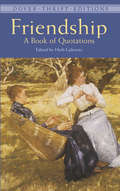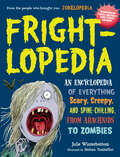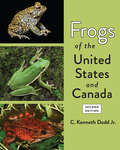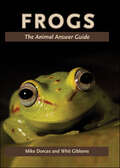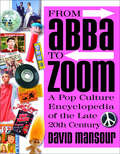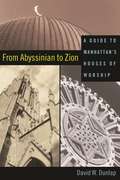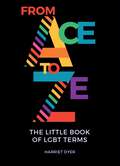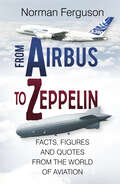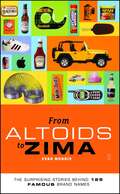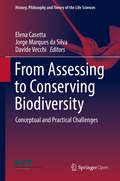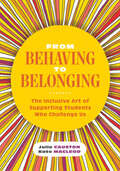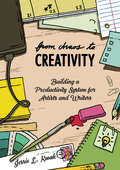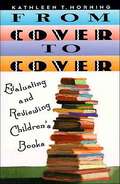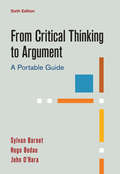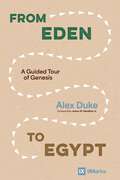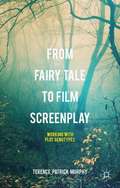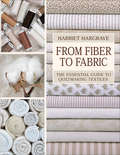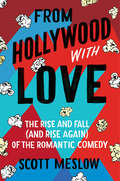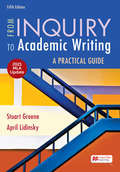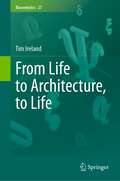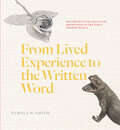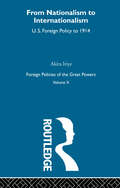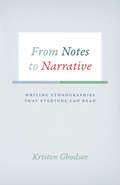- Table View
- List View
Friendship: A Book of Quotations (Dover Thrift Editions: Speeches/Quotations)
by Herb GalewitzOver 400 quotations, some more familiar than others, but all thoughtfully and precisely expressed. Includes such timeless observations as "A true friend is one soul in two bodies" (Aristotle) and "Friendship is like money, easier made than kept" (Samuel Butler). Also, thought-provoking reflections by Socrates, Confucius, Mark Twain, Dorothy Parker, Ambrose Bierce, and many others.
Frightlopedia: An Encyclopedia of Everything Scary, Creepy, and Spine-Chilling, from Arachnids to Zombies
by Julie WinterbottomHere’s the book for kids who love scary stuff, whether it’s telling ghost stories around a campfire, discovering the origins of various vampires, monsters, and witches, or reading creepy tales under the covers with a flashlight. Combining fact, fiction, and hands-on activities, Frightlopedia is an illustrated A-Z collection of some of the world’s most frightening places, scariest stories, and gruesomest creatures, both real and imagined. Discover Borneo’s Gomantong Cave, where literally millions of bats, cockroaches, spiders, and rats coexist—in pitch darkness. Learn about mythical creatures like the Mongolian Death Worm—and scarily real ones like killer bees, which were accidentally created by scientists in the 1950s. Visit New Orleans’s Beauregard-Keyes house, where Civil War soldiers are said to still clash in the front hall. Plus ghost stories from around the world, a cross-cultural study of vampires, and how to transform into a zombie with makeup. Each entry includes a “Fright Meter” measurement from 1 to 3, because while being scared is fun, everyone has their limit. A 2017 YALSA Quick Pick for Reluctant Readers.
Frogs of the United States and Canada
by C. Kenneth Dodd Jr.The most thorough, updated guide to frogs and toads in the United States and Canada available.A stunning diversity of frog species can be found from coastal swamps to lofty mountain peaks, and from the Florida Keys to the Arctic Ocean. They live in subtropical lowlands, grassland prairies, deserts, and alpine-tundra habitats. Some species have restricted habitat requirements, whereas others occur contiguously from the arid plains or humid southeastern forests to the high tundra. In this new edition of Frogs of the United States and Canada, C. Kenneth Dodd Jr. tours the reader through the marvelous world of North American frogs. Covering 114 native and introduced species from all US states and Canadian provinces, this comprehensive reference on the biology, behavior, and conservation of the Order Anura includes detailed and updated information on• past and present distribution • life history and demography • reproduction and diet• landscape ecology and evolution• diseases, parasites, and threats from toxic substances• conservation and management Hundreds of occurrence maps, line drawings, and new color photographs of frogs and their habitats enhance the text. The most thorough treatment of the life histories, distribution, and status of North American frogs ever produced, Frogs of the United States and Canada has been the go-to reference for naturalists, scientists, and resource managers in their efforts to understand and conserve frogs, their habitats, and biodiversity for over a decade. Based on a meticulously updated examination of more than 8,000 references current through 2021, this second edition ensures Dodd's master work will remain an unparalleled resource for years to come.
Frogs: The Animal Answer Guide (The Animal Answer Guides: Q&A for the Curious Naturalist)
by Mike Dorcas Whit GibbonsFrogs are amazingly diverse—ranging from the massive goliath frog, which weighs several pounds, to the recently discovered gold frog, which measures a mere three-eighths of an inch when fully grown—and have inhabited the earth for more than 200 million years. Today, however, these amphibians face more challenges than any other vertebrate group. In this fun and informative book, herpetologists Mike Dorcas and Whit Gibbons answer common and not-so-common questions people may have about these fascinating animals.Dorcas and Gibbons discuss how frogs evolved, which species currently exist in the world, and why some have recently gone extinct. They reveal what frogs eat and what eats them, their role in cultures across the globe, why many populations are declining and what we can do to reverse this dangerous trend, why there are deformed frogs, and much more. They answer expected questions such as "What is the difference between a frog and a toad?" and "Why do some people lick toads?" and unexpected ones such as "Why do some frogs lay their eggs in the leaves of trees?" and "Do frogs feel pain?" The authors’ easy-to-understand yet thorough explanations provide insight into the amazing biology of this amphibian group. In addressing conservation questions, Dorcas and Gibbons highlight the frightening implications of the current worldwide amphibian crisis, which many scientists predict will bring extinction rates experienced by frog species to levels not seen in any vertebrate animal group in millions of years.Packed with facts and featuring two color galleries and 70 black-and-white photographs, Frogs: The Animal Answer Guide is sure to address the questions on the minds of curious naturalists.
From Abacus to Zeus: A Handbook of Art History
by James Smith PierceChapters are 'Art terms, processes, and principles; gods, heroes, and monsters; Christian subjects; saints and their attributes; Christian signs and symbols.'
From Abba to Zoom: A Pop Culture Encyclopedia of the Late 20th Century
by David MansourMore than 150 million Americans were born after the post-World War II years. Almost all of them know, remember, and hold dear to their hearts the numerous memories that stretch From ABBA to Zoom.Take a walk . . . down memory lane, you Boomers and Gen Xers! From ABBA to Zoom is sure to grab anyone born in the 1950s, '60s, '70s, or '80s. Whether you grew up watching The Huckleberry Hound Show, Johnny Quest, or Sesame Street, this cultural encyclopedia is sure to draw you into a nostalgic and fun-filled read that you just can't put down.American pop culture aficionado David Mansour spent 18 years accumulating an extensive collection of dolls, lunch boxes, board games, TV memorabilia, and other items from the 1960s through the '90s. That fascination, along with his lifelong lists--from "best toys" to "all-time coolest singers"--were the genesis for this wide-ranging volume of Boomer and Generation X treasures.Readers will relish the mere mention of some of their greatest childhood and adolescent connections, then rush to learn the well-researched details behind those icons. Farrah Fawcett's feathered hair, James Bond movies, Lost in Space, Woodstock--it's all here! In page after page, more than 3,000 references arranged alphabetically make this a true trip through the Boom Times. Totally groovy!
From Abyssinian to Zion: A Guide to Manhattan's Houses of Worship
by David DunlapFrom modest chapels to majestic cathedrals, and historic synagogues to modern mosques and Buddhist temples: this photo-filled, pocket-size guidebook presents 1,079 houses of worship in Manhattan and lays to rest the common perception that skyscrapers, bridges, and parks are the only defining moments in the architectural history of New York City. With his exhaustive research of the city's religious buildings, David W. Dunlap has revealed (and at times unearthed) an urban history that reinforces New York as a truly vibrant center of community and cultural diversity.Published in conjunction with a New-York Historical Society exhibition, From Abyssinian to Zion is a sometimes quirky, always intriguing journey of discovery for tourists as well as native New Yorkers. Which popular pizzeria occupies the site of the cradle of the Christian and Missionary Alliance movement, the Gospel Tabernacle? And where can you find the only house of worship in Manhattan built during the reign of Caesar Augustus? Arranged alphabetically, this handy guide chronicles both extant and historical structures and includes 650 original photographs and 250 photographs from rarely seen archives 24 detailed neighborhood maps, pinpointing the location of each building concise listings, with histories of the congregations, descriptions of architecture, and accounts of prominent priests, ministers, rabbis, imams, and leading personalities in many of the congregations
From Ace to Ze: The Little Book of LGBT Terms
by Harriet DyerThis easy-to-use dictionary introduces some of the most essential terminology surrounding gender, sexuality and LGBTQIA+ identity. If you have questions about yourself or about the terminology, or even if you’re simply interested in learning more, this essential guide will help you navigate the world with knowledge and kindness.
From Airbus to Zeppelin: Facts, Figures and Quotes from the World of Aviation
by Norman FergusonA must-have A–Z guide with fascinating facts, figures, quotes and statistics from the high-flying world of aviation, From Airbus to Zeppelin has it all.D is for Desert Island Discs: just what would Dambuster Guy Gibson have liked while marooned on his desert island? E is for Everest: did you know that two Scotsmen were the first to fly over the magnificent mountain? F is for Faster than the sun: which aircraft was the first to fly faster than the Earth's rotation?A must-read for anyone interested in the world of aviation – and may win the reader a pub quiz or two!
From Altoids to Zima: The Surprising Stories Behind 125 Famous Brand Names
by Evan MorrisEver wondered what the Ms in M&Ms stand for? Was Scotch tape invented in Scotland? Why is a cereal that contains neither grapes nor nuts is called Grape Nuts? Who thought Gap was a good name for a clothing store? From the Adidas we wear to the Volkswagens we drive, the daily lives of Americans are dominated by the manufacturers' trademarks that adorn nearly everything we own. Food, clothes, cars, household furnishings, even cell phones are all chosen by brand name. Yet many of these trademarks and product names pose mysteries. But not when Evan Morris, creator of the award-winning The Word Detective website, is on the case! In From Altoids to Zima he reveals the fascinating, often wacky stories behind 125 brand names. Organized by product categories -- food and drink; clothing; technology, toys, and assorted bright ideas; cars; and drugs and cosmetics -- the story of each product is told with Morris's trademark wit and humor, complete with sidebars that highlight brand names that have become "genericized" (aspirin); a "What Were They Thinking?" honor roll of strange and often disastrous product names (Edsel); what happens when good brand names go bad (Kool-Aid after the Jonestown mass suicide); and debunked urban legends (the combination of Pop Rocks and soda that was rumored to be lethal).
From Assessing to Conserving Biodiversity: Conceptual and Practical Challenges (History, Philosophy and Theory of the Life Sciences #24)
by Elena Casetta Jorge Marques da Silva Davide VecchiThis open access book features essays written by philosophers, biologists, ecologists and conservation scientists facing the current biodiversity crisis. Despite increasing communication, accelerating policy and management responses, and notwithstanding improving ecosystem assessment and endangered species knowledge, conserving biodiversity continues to be more a concern than an accomplished task. Why is it so?The overexploitation of natural resources by our species is a frequently recognised factor, while the short-term economic interests of governments and stakeholders typically clash with the burdens that implementing conservation actions imply. But this is not the whole story. This book develops a different perspective on the problem by exploring the conceptual challenges and practical defiance posed by conserving biodiversity, namely: on the one hand, the difficulties in defining what biodiversity is and characterizing that “thing” to which the word ‘biodiversity’ refers to; on the other hand, the reasons why assessing biodiversity and putting in place effective conservation actions is arduous.
From Behaving to Belonging: The Inclusive Art of Supporting Students Who Challenge Us
by Julie Causton Kate MacLeodChallenging behavior is one of the most significant issues educators face. Though it may seem radical to use words like love, compassion, and heart when we talk about behavior and discipline, the compassionate and heartfelt words, actions, and strategies teachers employ in the classroom directly shape who students are—and who they will become. But how can teaching from the heart translate into effective supports and practices for students who exhibit challenging behavior? <P><P> In From Behaving to Belonging, Julie Causton and Kate MacLeod detail how teachers can shift from a "behavior management" mindset (that punishes students for "bad" behavior or rewards students for "good" or "compliant" behavior) to an approach that supports all students—even the most challenging ones—with kindness, creativity, acceptance, and love.
From Chaos to Creativity: Building a Productivity System for Artists and Writers
by Jessie L. KwakArt and writing can be the most fulfilling part of our lives. But it's often difficult to make space for it in our day-to-day existence, especially if we're not at the point yet where creating it is our job. Sometimes we have so many ideas it&’s difficult to keep them all organized, much less maintaining a creative schedule or dedicated workspace. With all the clutter overwhelming your scattered brain (not to mention your desk), it's all too easy to fall into procrastination and disarray. From Chaos to Creativity is a series of glowing beacon. Jessie L. Kwak has written a Getting Things Done for artists and writers, drawing on her experience as a professional copywriter with a novel-writing habit, and from interviews with other authors, artists, musicians, and designers, to teach you how to focus on the good ideas, manage your project, make time in your life, and execute your passions to completion. Make great art by channeling your chaotic creative force into productive power and let the world see what you're capable of!
From Cover to Cover: Evaluating and Reviewing Children's Book
by Kathleen T. Horning“[A] beautifully written how-to manual, which also manages to present a treatise on what is best in children’s literature and why. . . . An excellent resource.” —BooklistThis revised edition of From Cover to Cover offers a fresh, up-to-date look at some of the best examples of children’s literature and also includes practical advice on how to write clearly articulated, reasoned opinions so that others can learn about books they have not yet read.An updated introduction explains how children’s books evolve from manuscripts into bound books and the importance of the many different parts of a book (jacket flaps, title page, copyright, etc.) and changes in the children’s book industry, such as the creation of two new major genre awards. In addition, the author demonstrates how to think about and critically evaluate several different genres of children’s books.Included are sections about books of information; traditional literature (myths, legends, tall tales, folktales); poetry, verse, rhymes, and songs; picture books; easy readers and traditional books; and fiction and graphic novels. There is also a concluding chapter on how to write reviews that are both descriptive and analytical, including a segment on children’s literature blogs.Updated material includes:•Information on the many changes in the children’s book industry•A section on genres•A section on children’s literature blogs•An introduction of two new major genre awards: the Robert F. Sibert Informational Book Award and the Theodor Seuss Geisel Award•And more than 90% of the books cited have been updated from the first edition to more recent publications!“[A] very complete resource that will continue to be the venerable reference tool.” —School Library Journal“An excellent guide.” —ALA Booklist
From Critical Thinking to Argument: A Portable Guide
by Barnet Badau O’HaraFrom Critical Thinking to Argument is a brief but thorough guide to argument at a great value. This versatile text gives students strategies for critical thinking, reading, and writing and makes argument concepts clear through its treatment of classic and modern approaches to argument, including Aristotelian, Toulmin, and Rogerian argument, as well as visual rhetoric. For today’s increasingly visual learners who are challenged to separate what’s real from what’s not, new activities and visual flowcharts support information literacy, and an appendix of practical Sentence Guides helps students incorporate the moves of academic writers into their own arguments. With just eighteen readings, this affordable guide can stand alone or complement an anthology.
From Eden to Egypt: A Guided Tour of Genesis (9Marks)
by Alex DukeThe Bible is one story told through dozens of people over thousands of years. As Christians, we know we're supposed to believe this - and so we do. But when we pick up our Bibles, if we're honest, we sometimes lose the thread, especially with some of the strange and obscure happenings in Genesis.We can't help but wonder, What's this all about?!Who- or what - are the Nephilim? What about this mysterious Melchizedek who seems to appear out of nowhere? Why are there so many genealogies? Why do Abraham and a Hittite haggle for so long about the price of a rinky-dink cave? Hang on, are we supposed to be comfortable with Abraham sacrificing his son? Or with Lot's, um, unseemly family dynamics? Or with Jacob's multiple wives? Why do the book's heroes so often act like villains?And, of course, what does all this have to with Jesus and the gospel?Careful readers of the Bible have many questions about Genesis. In From Eden to Egypt, Alex Duke will give everyday Christians a guided tour of these wonderful stories so that they'll see - perhaps for the first time - that it's all there for a reason.
From Elvish To Klingon: Exploring Invented Languages
by Michael AdamsFrom the Elvish language Tolkien invented for denizens of Middle Earth to the science fiction lingo spoken by the Klingons in Star Trek, writers have always endeavored to create new forms of expression, not only in the English language, but in languages that exist only in their own imaginations.
From Fairy Tale to Film Screenplay: Working with Plot Genotypes
by Terence Patrick MurphyIn Screenplay: The Foundations of Screenwriting (1979), Syd Field first popularized the Three-Act Paradigm of Setup, Confrontation and Resolution for conceptualizing and creating the Hollywood screenplay. For Field, the budding screenwriter needs a clear screenplay structure, one which includes two well-crafted plot points, the first at the end of Act I, the second at the end of Act II. By focusing on the importance of the four essentials of beginning and end, and the two pivotal plot points, Field did the Hollywood film industry an enormous service. Nonetheless, although he handles the issue of overall structure expertly, Field falls down when offering the screenwriter advice on how to successfully build each of the three individual Acts. This is because Field did not recognize the importance of another layer of analysis that underpins the existence of plot points. This is the level of the plot genotype.This book will offer you a richer theory of plot structure than the one Field outlines. It will do this not by contradicting anything Field has to say about the Hollywood paradigm, but by complementing it with a deeper level of analysis. Plot genotypes are the compositional schemas of particular stories. They are sets of instructions, written in the language of the plot function, for executing particular plots. This book outlines the plot genotypes for The Frog Prince, The Robber Bridegroom, Puss-in-Boots, and Little Red Riding Hood and then shows how these genotypes provide the underpinnings for the film screenplays of Pretty Woman, Wrong Turn, The Mask, and Psycho. By means of a detailed study of these four Hollywood screenplays, you will be able to offer a much richer description of what is going on at any particular point in a screenplay. In this way, you will become much sharper at understanding how screenplays work. And you will become much better at learning how to write coherent screenplays yourself.
From Fiber to Fabric: The Essential Guide to Quiltmaking Textiles
by Harriet HargraveThe quilter&’s definitive resource on the selection, use, and care of today&’s textiles. This book from an internationally known quiltmaker and teacher is a thorough reference filled with fabric facts. Along with easy-to-understand directions for testing fiber content, thread count, colorfastness, lightfastness, washfastness, and shrinkage, you&’ll find: Information on the effects of water and detergents on different fabrics and dyesThread compatibility and batting selection chartsRecommendations for storing quilts With a better understanding of how textiles are made, what to consider when buying them, and how to care for them once you bring them home, you will have much more enjoyment and less stress as you create your wonderful quilts.
From Hollywood with Love: The Rise and Fall (and Rise Again) of the Romantic Comedy
by Scott MeslowAn in-depth celebration of the romantic comedy’s modern golden era and its role in our culture, tracking the genre from its heyday in the ’80s and the ’90s, its unfortunate decline in the 2000s, and its explosive reemergence in the age of streaming, featuring exclusive interviews with the directors, writers, and stars of the iconic films that defined the genre.No Hollywood genre has been more misunderstood—or more unfairly under-appreciated—than the romantic comedy. Funny, charming, and reliably crowd-pleasing, rom-coms were the essential backbone of the Hollywood landscape, launching the careers of many of Hollywood’s most talented actors and filmmakers, such as Julia Roberts and Matthew McConaughey, and providing many of the yet limited creative opportunities women had in Hollywood. But despite—or perhaps because of—all that, the rom-com has routinely been overlooked by the Academy Awards or snobbishly dismissed by critics. In From Hollywood with Love, culture writer and GQ contributor Scott Meslow seeks to right this wrong, celebrating and analyzing rom-coms with the appreciative, insightful critical lens they’ve always deserved. Beginning with the golden era of the romantic comedy—spanning from the late ’80s to the mid-’00s with the breakthrough of films such as When Harry Met Sally—to the rise of streaming and the long-overdue push for diversity setting the course for films such as the groundbreaking, franchise-spawning Crazy Rich Asians, Meslow examines the evolution of the genre through its many iterations, from its establishment of new tropes, the Austen and Shakespeare rewrites, the many love triangles, and even the occasional brave decision to do away with the happily ever after. Featuring original black-and-white sketches of iconic movie scenes and exclusive interviews with the actors and filmmakers behind our most beloved rom-coms, From Hollywood with Love constructs oral histories of our most celebrated romantic comedies, for an informed and entertaining look at Hollywood’s beloved yet most under-appreciated genre.
From Inquiry to Academic Writing: A Practical Guide with 2021 MLA Update
by Stuart Greene April LidinskyThis ebook has been updated to provide you with the latest guidance on documenting sources in MLA style and follows the guidelines set forth in the MLA Handbook, 9th edition (April 2021).From Inquiry to Academic Writing: A Practical Guide. Interesting readings from across the disciplines combine with a step-by-step approach you can apply to your own writing inside and outside of academia.
From Life to Architecture, to Life (Biosemiotics #27)
by Tim IrelandThe book establishes a correlation between architectural theory and the biosemiotic project, and suggest how this coupling establishes a framework leading to an architectural-biosemiotic paradigm that puts biosemiotic theory at the heart of cognising the built environment, and offers an approach to understanding and shaping the built environment that supports (and benefits) human, and organismic, spatial intelligence.
From Lived Experience to the Written Word: Reconstructing Practical Knowledge in the Early Modern World
by Pamela H. SmithHow and why early modern European artisans began to record their knowledge. In From Lived Experience to the Written Word, Pamela H. Smith considers how and why, beginning in 1400 CE, European craftspeople began to write down their making practices. Rather than simply passing along knowledge in the workshop, these literate artisans chose to publish handbooks, guides, treatises, tip sheets, graphs, and recipe books, sparking early technical writing and laying the groundwork for how we think about scientific knowledge today. Focusing on metalworking from 1400–1800 CE, Smith looks at the nature of craft knowledge and skill, studying present-day and historical practices, objects, recipes, and artisanal manuals. From these sources, she considers how we can reconstruct centuries of largely lost knowledge. In doing so, she aims not only to unearth the techniques, material processes, and embodied experience of the past but also to gain insight into the lifeworld of artisans and their understandings of matter.
From National To Intnlsm V10: U. S. Foreign Policy Before 1917 (Foreign Policies Of The Great Powers Ser.)
by IriyeFirst published in 2001. Routledge is an imprint of Taylor & Francis, an informa company.
From Notes to Narrative: Writing Ethnographies That Everyone Can Read (Chicago Guides to Writing, Editing, and Publishing)
by Kristen GhodseeEthnography centers on the culture of everyday life. So it is ironic that most scholars who do research on the intimate experiences of ordinary people write their books in a style that those people cannot understand. In recent years, the ethnographic method has spread from its original home in cultural anthropology to fields such as sociology, marketing, media studies, law, criminology, education, cultural studies, history, geography, and political science. Yet, while more and more students and practitioners are learning how to write ethnographies, there is little or no training on how to write ethnographies well. From Notes to Narrative picks up where methodological training leaves off. Kristen Ghodsee, an award-winning ethnographer, addresses common issues that arise in ethnographic writing. Ghodsee works through sentence-level details, such as word choice and structure. She also tackles bigger-picture elements, such as how to incorporate theory and ethnographic details, how to effectively deploy dialogue, and how to avoid distracting elements such as long block quotations and in-text citations. She includes excerpts and examples from model ethnographies. The book concludes with a bibliography of other useful writing guides and nearly one hundred examples of eminently readable ethnographic books.
